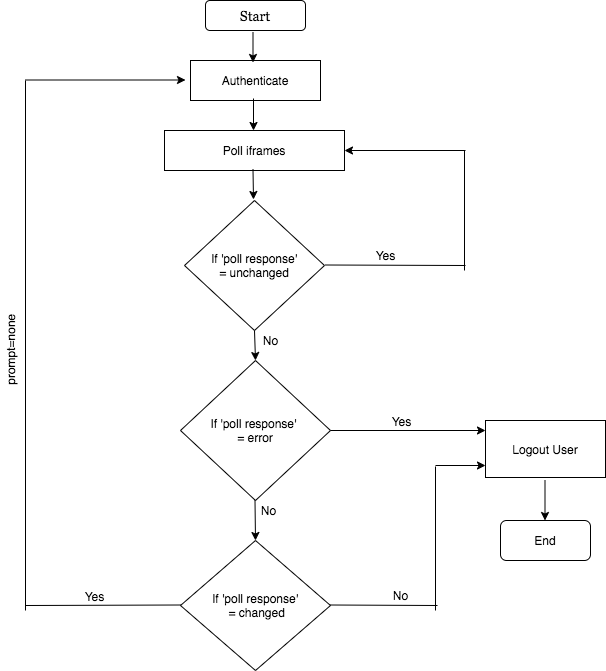OpenID Connect Session Management¶
The OpenID Connect Session Management specification defines methodologies to manage user sessions and log out end-users at the authorization server using front-channel communication. In this approach, the login/logout requests from the RP (Relying Party or the client application) to OP (OpenID Provider) and OP to RP are done via the user agent (browser based).
Obtain user’s logging state¶
To obtain the user’s logging state, the specification recommends the approach of polling a hidden OP iframe from an RP iframe with an origin restricted postMessage. The main advantage of this approach is that it will not cause any network traffic.
OP iframe¶
The OP iframe loads on the RP side based on the OP’s check_session_iframe endpoint. The OP iframe must enforce that the caller has the same origin as its parent frame. It must reject postMessage requests from any other source origin.
RP iframe¶
This iframe loads on the RP side and it should know the ID of the OP iframe. This iframe can postMessage to the OP iframe. RP iframe should continuously post messages (poll) to the OP iframe at an interval as per the application requirements.
Session State¶
Session state is a JSON string that represents the end-user's login state at the OP. The session_state value contains "a salted cryptographic hash of Client ID, origin URL, and OP browser state". The OP passes this value to the RP in the authentication response and the RP uses this value to monitor end-user session at the OP.
Session Management Endpoints¶
OpenID Connect uses the following two endpoints for session management.
-
check_session_iframe: This endpoint supports cross-origin communications for session state information with the client, using the HTML5 postMessage API. It accepts postMessage requests from the relevant RP iframe and uses postMessage to post back the login status of the end-user at the OpenID Provider.
-
end_session_endpoint: This endpoint is responsible for logging out an end-user once the client performs a redirect request.
How does OpenID Connect Session Management work?¶
The following diagram represents the flow.

- Once the end-user needs to log in to the RP, the RP sends an authentication request to the OP.
- The OP responds back with the session_state.
- The RP iframe continuously polls the OP iframe to detect any state changes.
- The OP iframe responds with one of the following statuses.
The status can be either;
- changed: This indicates that user-session is still valid at the OP. RP will continue to poll OP iframe to detect any session changes.
- unchanged: This indicates that the session has changed at the OP.
This can happen due to user logout, session timeout, or a user logging in from a different client application.
Upon receipt of the
changedstate, the RP performs re-authentication with prompt=none to obtain the current session state at the OP. - error: This indicates the message sent was determined by the OP to be malformed.
Upon receipt of error, the RP must not perform re-authentication with
prompt=none, so as to not cause potential infinite loops that generate network traffic to the OP, it directly logs the user out.
RP-Initiated Logout¶
In RP-initiated logout, once an end-user is logged out from the RP, it can notify the OP regarding that. In this case, the RP, after having logged the end-user out of the RP, redirects the end-user’s user agent to the OP’s logout endpoint URL. This URL is obtained via the end_session_endpoint described above.
Following parameters are optional and recommended to be passed as query parameters in the logout request.
- id_token_hint
This is the previously issued ID Token. This should be passed to the logout endpoint as a hint about the end-user’s current authenticated session with the client. This is used as an indication of the identity of the end-user that the RP is requesting to be logged out by the OP. The OP need not be listed as an audience of the ID Token when it is used as an id_token_hint value.
- post_logout_redirect_uri
This is the URL to which the RP is requesting that the end-user’s user agent be redirected after a logout has been performed. The value should have been previously registered with the OP.
- state
An opaque value used by the RP to maintain the state between the logout request and the callback to the endpoint specified by the post_logout_redirect_uri query parameter. If included in the logout request, the OP passes this value back to the RP using the state query parameter when redirecting the user agent back to the RP.
Top